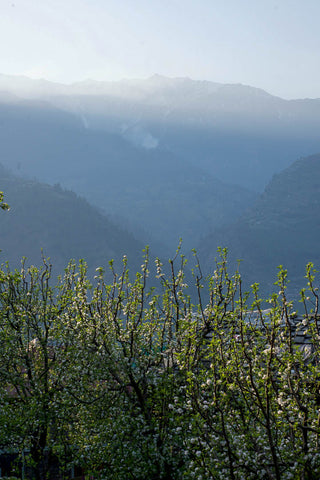Wool: Then and Now

A traiditonal Kathkuni House near Manali, Himachal Pradesh
Kullu Valley, Himachal Pradesh
Prior to the 1950s-60s, an interdependent network existed between the semi-nomadic shepherd communities and the farmers of the agrarian villages in the Kullu Valley.
When the shepherds travelled with their herds of sheep and goats from the high mountain passes to the valleys, the sheep would graze in the farm fields, providing much needed fertilizer, and the villagers would use the sheep's wool to weave and knit garments and blankets for the winter months.
Over time, various influences caused this network to weaken and break down.

Apple trees in blossom in Naggar, Himachal Pradesh. The arrival of apple trees, and subsequently the initiative to bring apple farms in the Kullu Valley directly affected the pastoralist shepherd communities in the 60's, as sheep were no longer welcome in the new orchards.
With the arrival of cheap and accessible synthetic yarns in the local markets, artisans began to incorporate these petroleum based yarns into their weaving and knitting. Further, imported merino wool began to be used in commercial production.
The resulting decrease in demand for local indigeous wool undermined the ability of the pastoralist shepherd communities to continue their traditional way of life, and contributed to a loss of knowledge and skills amongst local artisans in being able to work with local wool.
Further, synthetic yarns are not biodegradable, and contain synthetic dyes, and imported merino wool carries the environmental impact of importing from afar, and the mass farming of single breed sheep.

A traditional handwoven pattu hangs on the verandah to dry, protected from the rain. Pattus are worn by Kullvi Women, wrapped around the body and joined using a fibula - a pin decorated with stones and a chain. In the 60's, bright colours were added into Pattu designs using acrylic yarns.

Naturally dyed handspun indigenous wool hangs in the new open air building where Kullvi WHIMS meet for dyeing and workshops.
RANI & REINE
Wool Sourcing
RANI & REINE is committed to using natural fibres in all of our products, as well as incorporating indigenous fibres into our supply chain wherever we can.
Indigenous means that the fibre - such as wool or cotton - originates from the area where it is sourced; native. This means we use wool that comes from the local Gaddi and Lahauli sheep breeds that have been raised for generations in Kullu and Lahaul Spiti.

April 2022. A Lahauli sheep - these sheep are the result of a breeding program in the 60's that crossed the local indigenous sheep with merino and rambouillet, creating a softer wool. We use this wool in our next to skin products.
Our designs are created within the confines of a complex and inconsistent wool supply chain in terms of access to breed and herd specific wool, specific colours, and raw fleece.
Kullvi WHIMS, our artisan partners, purchase our Gaddi wool from various families in the surrounding villages, based on word of mouth and family connections. Our Lahauli wool comes from a tiny village about 150 kms from where our artisan partners live.

Purchasing Wool: Palmo, one of the women from Lahaul who's family raises sheep, pulls a brown sheep's fleece out of a sac for us to look at. April 2022.
It's important to know that we don't source from a farm - it's a small remote village, where each family has a small herd of sheep and goats.
Each day, family members take the animals into the surrounding hills to graze, and during the summer months, they hire semi-nomadic shepherds to take the herds up into the high mountain passes, treking for thousands of kilometres before returning to the valleys for the Fall shearing.

Sheep and goats make their way up into the hills for the day to graze. 100's of sheep emerged from the houses below, in small groups of 10-30, bells jingling around their necks, accompanied by the odd guttural sound made by the women and men urging them to move onwards. April 2022.
Our intention has always been to form direct partnerships with shepherds to source our wool. Our goal is flock to frock sourcing, where we can trace our wool directly back to the sheep, herd and shepherd.
In April 2022, we were finally able to travel to the village where our Lahauli wool is sourced. This is a huge step towards being able to create a transparent supply chain.

The valley in Lahaul where we source our Lahauli wool. April 2022.